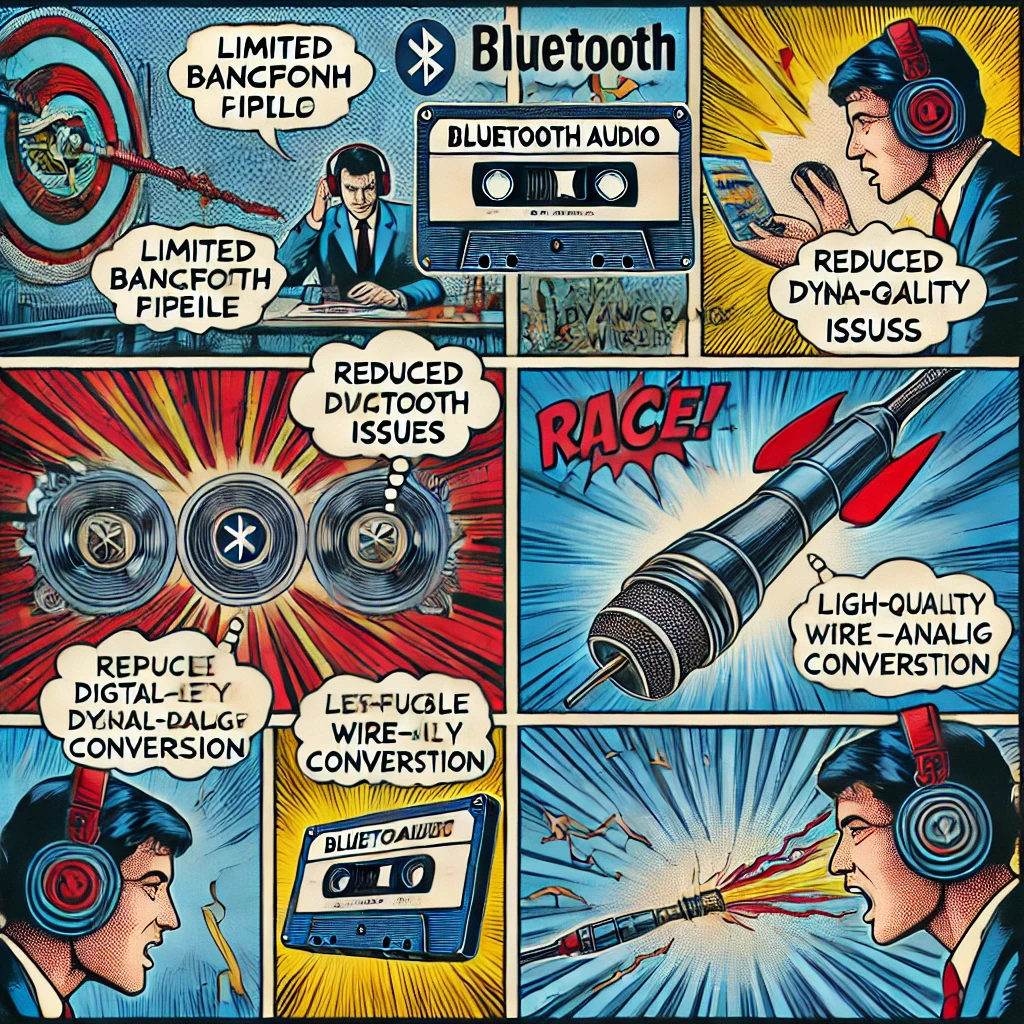Sound Quality Bluetooth
Exploring Bluetooth Sound Quality: Unveiling the Limitations and Artifacts
In the realm of portable audio, Bluetooth has revolutionized how we consume music, offering unparalleled convenience. However, audiophiles and casual listeners alike often debate its sound quality compared to traditional wired connections. This blog post delves into the nuances of Bluetooth audio, examining the technological constraints that impact its fidelity.
Bandwidth Limitations and Mathematical Compression
Bluetooth audio operates within a constrained bandwidth, typically around 1-3 Mbps for standard codecs like SBC (Subband Coding) or AAC (Advanced Audio Coding). This limitation necessitates significant data compression to transmit audio wirelessly. Mathematical algorithms compress audio data to fit within these confines, inevitably introducing artifacts that can degrade sound quality.
Audible Artifacts: A Trade-Off of Compression
Compression algorithms such as lossy codecs sacrifice some audio data to achieve smaller file sizes. This compromise results in perceptible artifacts like reduced dynamic range, loss of subtle details, and occasional distortions in complex passages. While advancements like aptX and LDAC mitigate these issues, they are not universally adopted, perpetuating variable quality across devices.
Digital Constraints on Sound Quality
Beyond bandwidth, other digital factors affect Bluetooth sound quality. Latency, inherent in wireless transmission, can create temporal distortions, particularly noticeable when viewing video or gaming. Additionally, the digital-to-analog converters (DACs) and amplifiers within Bluetooth devices vary widely in quality, influencing the final audio output.
Temporal and Volumetric Compressions: Altered Musical Experience
Bluetooth’s digital transmission can subtly alter music. Temporal compression may affect timing and rhythm, while volumetric compression alters spatial perception, diminishing the expansive soundstage achievable with wired setups. These nuances may be imperceptible to casual listeners but are significant to audiophiles.
Why Bluetooth Lags Behind Wired Audio
Despite advancements, Bluetooth generally offers inferior sound quality compared to wired connections. Wired audio paths, typically using higher-bandwidth codecs or uncompressed formats, deliver pristine sound fidelity without the artifacts and limitations of wireless transmission. The direct, analog signal transmission avoids digital conversions and compression, preserving the artist’s intended sound with greater integrity.
In conclusion, while Bluetooth excels in convenience and portability, its sound quality compromises are inherent. Bandwidth limitations necessitate significant data compression, introducing audible artifacts and altering the music’s temporal and volumetric characteristics. Audiophiles and discerning listeners often prefer wired connections for their superior fidelity and minimal digital interference. As technology advances, bridging this gap remains a challenge, but for now, understanding these digital constraints helps appreciate both the convenience and compromises of Bluetooth audio.
An extremely interesting test
All things being kept as equal and unchanging as possible (to reduce the number of scientific variables), play a lossless recording over an audio system and record it. Duplicate everything but insert a transmission leg over bluetooth connectivity (instead of wired); record this audio outcome. Compare the two recordings by subtracting one from another. A readily-identifiable “ghosting” will be immediately apparent, suggesting a perceptible loss of sound quality.
Limitations and artifacts of Bluetooth audio
Bandwidth Constraints and Compression
Bluetooth audio operates within a limited bandwidth, typically around 1–3 Mbps for standard codecs like SBC (Subband Coding) or AAC (Advanced Audio Coding). To transmit audio wirelessly within these constraints, significant data compression is applied, which can introduce artifacts that degrade sound quality.
Audible Artifacts from Compression
The compression algorithms used in Bluetooth audio, often lossy codecs, sacrifice some audio data to achieve smaller file sizes. This process can result in perceptible artifacts such as reduced dynamic range, loss of subtle details, and occasional distortions in complex musical passages. While advancements like aptX and LDAC aim to mitigate these issues, their adoption is not universal, leading to variable audio quality across different devices.
Digital Constraints Affecting Sound Quality
Beyond bandwidth limitations, other digital factors impact Bluetooth sound quality. Latency inherent in wireless transmission can cause temporal distortions, particularly noticeable during video playback or gaming. Additionally, the quality of digital-to-analog converters (DACs) and amplifiers within Bluetooth devices varies widely, influencing the final audio output.
Temporal and Volumetric Compressions
Bluetooth’s digital transmission can subtly alter music through temporal compression, affecting timing and rhythm, and volumetric compression, which alters spatial perception and diminishes the expansive soundstage achievable with wired setups. These nuances, while possibly imperceptible to casual listeners, are significant to audiophiles.
Comparison with Wired Audio
Despite technological advancements, Bluetooth generally offers inferior sound quality compared to wired connections. Wired audio paths, typically using higher-bandwidth codecs or uncompressed formats, deliver pristine sound fidelity without the artifacts and limitations inherent in wireless transmission. The direct analog signal transmission in wired setups avoids digital conversions and compression, preserving the artist’s intended sound with greater integrity.
Conclusion
While Bluetooth provides exceptional convenience and portability, its sound quality compromises are inherent due to bandwidth limitations necessitating data compression, which introduces audible artifacts and alters the music’s temporal and spatial characteristics. Audiophiles and discerning listeners often prefer wired connections for their superior fidelity and minimal digital interference. As technology advances, bridging this gap remains a challenge, but understanding these digital constraints helps appreciate both the convenience and compromises of Bluetooth audio.
The article also suggests an interesting test to highlight these differences:
- Play a lossless recording over an audio system and record it.
- Repeat the process, but insert a transmission leg over Bluetooth connectivity instead of a wired connection, and record this audio outcome.
- Compare the two recordings by subtracting one from another.
This comparison may reveal a readily identifiable “ghosting,” suggesting a perceptible loss of sound quality due to Bluetooth transmission.
In summary, while Bluetooth audio offers convenience, it comes with trade-offs in sound quality due to compression and digital processing. For those prioritizing audio fidelity, wired connections remain the preferred choice.
